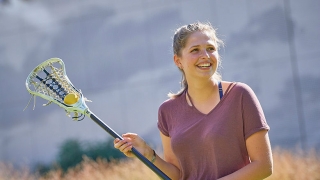Crohn’s Disease: Lucy’s Story
Published on
Published on
Lucy, 16, loves to socialize with friends, play sports and bake. Lucy also has a unique talent — she’s becoming an expert on special-effects makeup. She has Crohn’s disease but doesn’t feel defined by her condition. Crohn’s used to keep Lucy on the sidelines, but now she has big ambitions for the future, thanks to her breakthrough at Children’s Hospital.
 Lucy was about to turn 13 in Dec. 2013 when her parents, Polly and Ken, noticed that she was growing thinner. Normally a big eater, Lucy didn’t have an appetite, and she started to have occasional stomach aches. At first they chalked it up to the stresses of early adolescence, but the stomach aches continued and she grew even thinner.
Lucy was about to turn 13 in Dec. 2013 when her parents, Polly and Ken, noticed that she was growing thinner. Normally a big eater, Lucy didn’t have an appetite, and she started to have occasional stomach aches. At first they chalked it up to the stresses of early adolescence, but the stomach aches continued and she grew even thinner.
In mid-March, a concerned Ken asked Lucy to weigh herself. They discovered that she had lost 12 pounds since a regular medical check-up in November. The next day, Ken took Lucy to their family doctor in nearby Buckingham, Pennsylvania, who examined her and took blood samples.
When the results of the blood work came back, the doctor called the family immediately — the tests showed signs of inflammation. The doctor suspected that Lucy had celiac disease or a form of inflammatory bowel disease (IBD), either Crohn’s disease or ulcerative colitis. He referred Lucy to a pediatric gastroenterologist.
She had a colonoscopy and endoscopy so that a specialist could do a visual scan for inflammation and take tissue samples (biopsies) for examination under a microscope. The biopsy results confirmed that Lucy had Crohn’s disease.
Lucy was started on Pentasa® (mesalamine), one of the milder medications for treating IBD. It works by decreasing inflammation in the small and large intestines. Lucy also made some changes to her diet to avoid foods that could contribute to the inflammation.
The initial treatment didn’t provide much relief. Lucy still couldn’t keep food down and was becoming weaker. At lacrosse games, she didn’t have the stamina to stay on the field. She kept going to the practices and games, but was limited to throwing the ball on the sidelines.
In April, things took a turn for the worse. Lucy started vomiting, and Ken and Polly brought her back to her pediatrician. Just under 5 feet tall, her weight had dropped to an alarming 70 pounds — and the doctor couldn’t find a pulse. The family went straight to the emergency room.
Lucy was having difficulty breathing, so X-rays were taken of her chest and abdomen. The images showed that her intestine was very distended and partially obstructed. That night she was transferred to Children’s Hospital of Philadelphia (CHOP), where more X-rays and a CT scan were performed.
The family met with pediatric gastroenterologists Andrew B. Grossman, MD, who is Co-director of CHOP's Center for Pediatric Inflammatory Bowel Disease (IBD), and Máire Conrad, MD. The Center for Pediatric IBD is one of the largest of its kind in the U.S.
After examining Lucy and reviewing her test results and imaging studies, they explained that Lucy had a large abscess in her abdomen that was obstructing her intestine. This was unfortunately due to the inflammation from her Crohn’s disease.
Drs. Grossman and Conrad proposed to drain the abscess and then surgically remove the damaged portion of Lucy’s lower intestine. To supplement the Pentasa, they put her on prednisone and antibiotics as a short-term measure to reduce the inflammation. After the surgery, they recommended changing her medication to Remicade®, a biologic immune suppressant that would be administered in periodic infusions.
It took two-and-a-half weeks to drain the abscess and decrease the inflammation, and then Lucy had surgery to remove what turned out to be two damaged sections of her intestine. Two days later, her appetite was coming back, and she was able to enjoy food again. Within a few days, she was eating her favorite meals again, including pancakes and bacon.
Lucy stayed at CHOP for 10 days after the surgery. Before her release, she received her first infusion of Remicade, with a plan for subsequent doses at lengthening intervals — two weeks, then four weeks, then eight weeks apart.
“chop was wonderful. the medical team explained everything to us very clearly. the doctors spoke directly to Lucy, rather than talking past her to ken and me, which we loved. the nurses were fantastic. they treated us like we were guests.”
 The surgery and the change in medication transformed Lucy. She started back at playing lacrosse just three weeks after her procedure. By the summer, she was on the field running with much of her former stamina. A few months later, she regained her strength and the weight she had lost. The stomach aches and vomiting stopped, and she could eat almost anything she wanted again.
The surgery and the change in medication transformed Lucy. She started back at playing lacrosse just three weeks after her procedure. By the summer, she was on the field running with much of her former stamina. A few months later, she regained her strength and the weight she had lost. The stomach aches and vomiting stopped, and she could eat almost anything she wanted again.
Lucy has taken one piece of advice from Dr. Grossman to heart. He urged her not to let the disease define her, and she hasn’t. Lucy finds herself appreciating her interests even more now. She pushes herself harder in sports and has become more creative in the kitchen to invent new baked delights.
Like many teenagers, Lucy has started to think about her future career goals. She wants to become a nurse or a theatrical makeup artist when she’s an adult. No matter what she chooses, Lucy has big ambitions and an appreciation for life.